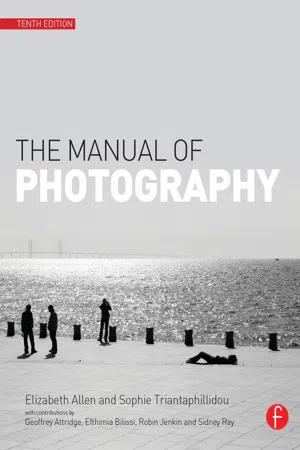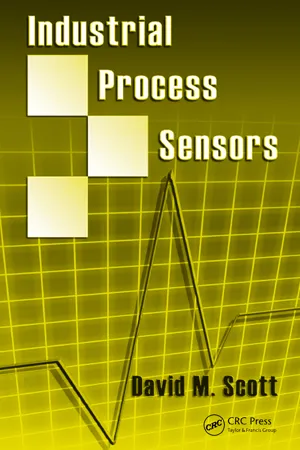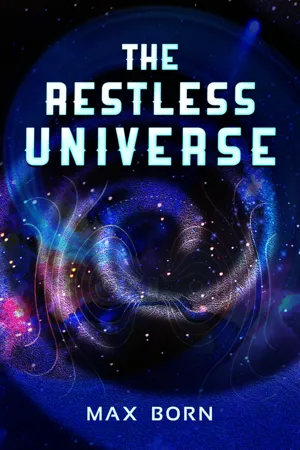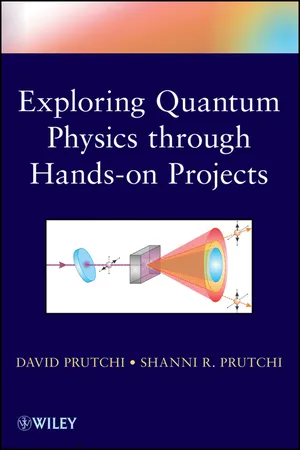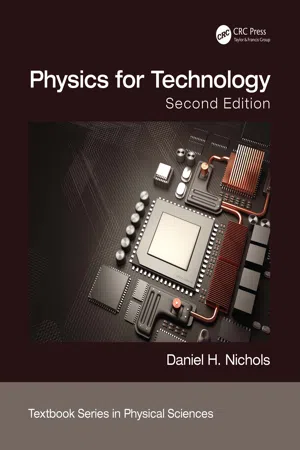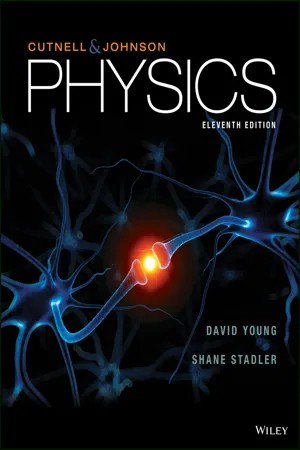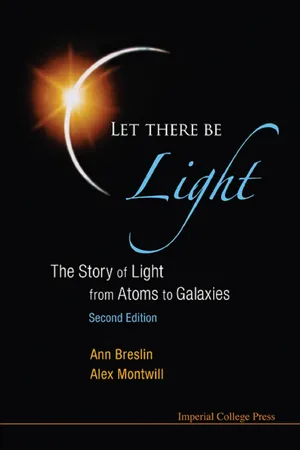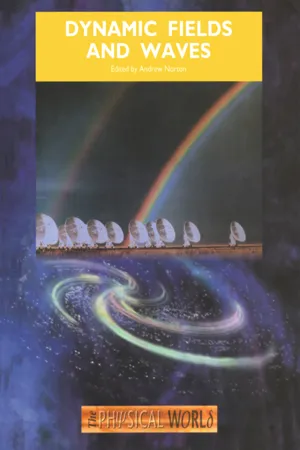Physics
Light Waves
Light waves are electromagnetic waves that travel through space and carry energy. They are characterized by their wavelength and frequency, with shorter wavelengths corresponding to higher frequencies and vice versa. Light waves exhibit properties of both waves and particles, and they can be described using the wave-particle duality concept in quantum mechanics.
Written by Perlego with AI-assistance
Related key terms
11 Key excerpts on "Light Waves"
- eBook - ePub
- Elizabeth Allen, Sophie Triantaphillidou(Authors)
- 2012(Publication Date)
- Routledge(Publisher)
It is now accepted that a complete understanding of the nature of light must recognize both wave and particle theories as valid. This is termed wave–particle duality and is extended in current scientific theory to all matter at a quantum level: the idea that any object existing in the form of particles must also exhibit wave-like behaviour. THE NATURE OF LIGHT Light is a form of electromagnetic radiation (or radiant flux), which is emitted from various sources, most obviously the sun. Electromagnetic radiation is a self-propagating wave of energy which travels through empty space at a particular speed and consists of oscillations in electric and magnetic fields. As established by Maxwell, all electromagnetic radiation travels at the same speed in vacuum, † that is approximately 2.998 × 10 8 ms −1. When electric charges move, they are accompanied by a magnetic field. If the charges accelerate or decelerate, then disturbances occur in both the electric and magnetic fields and radiation is emitted in a wave motion, carrying energy away from the disturbed charges. The fields oscillate at right angles to each other. They are also at right angles to the direction in which the wave is moving. Furthermore, electromagnetic waves exhibit rectilinear propagation – that is, a single point on a wave, if unimpeded, is propagated in a straight line. Electromagnetic radiation exists at a wide range of wavelengths or frequencies and these are collectively termed the electromagnetic spectrum (see page 35). In general, in photography and digital imaging we are more correctly referring to the visible spectrum – that is, the range of wavelengths of electromagnetic radiation that are detectable by the human visual system - eBook - ePub
Making Physics Fun
Key Concepts, Classroom Activities, and Everyday Examples, Grades K?8
- Robert Prigo(Author)
- 2015(Publication Date)
- Skyhorse(Publisher)
So the particle picture of light was back on the scene. Indeed, the nature of light turned out to be much more interesting than an either-or particle or wave reality. Both descriptions are needed for a full picture of light. This complementary picture is known as the wave-particle duality for light. The dual nature of light, propagating as an electromagnetic wave while interacting with matter through particle-like photons, sums up our present understanding of light. This wave-particle duality is now known to be a universal property of nature. Based on an analogy with the dual nature of light, Louis de Broglie (1892–1987) proposed that matter itself (electrons, atoms, etc.) might show the same duality. He proposed that particles such as electrons might have wave-like features. His ideas were soon put to the test and vindicated when experiments revealed the diffraction and superposition of electrons! All forms of light, both visible and nonvisible, share many fascinating characteristics and properties. Light does not need a medium through which to propagate. It can propagate in a vacuum. Light is made up of oscillating and self-sustaining electric and magnetic fields that interact with matter in a particle-like way (photons). Light travels at a constant speed in a vacuum (299,792,458 meters per second). In a transparent material, light travels at a slower speed, with different frequencies traveling at slightly different speeds. In a vacuum and in uniform transparent materials, light travels in straight lines. Some objects reflect light, some absorb light, and some do both. Light bends— refracts —when it propagates from one transparent medium into another. Visible light comes in a narrow but continuous spectrum of frequencies that we detect as different colors (red to violet). “White” light is composed of light of different colors (red to violet). “Black” is the absence of light - eBook - ePub
- David M. Scott(Author)
- 2018(Publication Date)
- CRC Press(Publisher)
4 Light 4.1 Electromagnetic WavesScientific inquiry took millennia to ascertain the true nature of light, and it is not possible here to attempt to recapitulate all of the philosophizing, hypotheses, arguments, and experimentation involved in that great debate. The main point of controversy was whether light should be considered as a particle or as a wave. Empedocles of Acragas (492–432 B.C.E .) was of the opinion that light is a “streaming substance” emitted by luminous bodies, and that light travels at a finite speed (Sambursky, 1958). In the seventeenth century, Isaac Newton postulated that light is composed of particles and that color is connected with the size of those particles; however, his contemporary Christiaan Huygens argued that light is a wave that transfers energy but not substance (Einstein & Infeld, 1966, p. 105ff). It turns out that light is indeed a wave propagating via electric and magnetic fields, but in addition to exhibiting properties of waves (such as interference) it also exhibits properties of particles (such as momentum and localization). When treating light as particles, the individual quanta are called photons.Electromagnetic phenomena, including light, are described by Maxwell’s four equations, which are easily found in most introductory physics textbooks (see for example Halliday et al., 2005, p. 868). These equations describe the mathematical connections between electrical charge, current, electric field, and magnetic field. The details of these equations and their interpretation are not of immediate concern to us here. However, a particularly interesting result is that these four equations can be combined to produce a relatively simple equation (Feynman et al., 2006, vol. 2, Lecture 18):+∂ 2ϕ∂x 2+∂ 2ϕ∂y 2−∂ 2ϕ∂z 21c 2= −∂ 2ϕ∂t 2ρε 0(4.1) where ω is the electric potential, ρ is the electrical charge density, and ε0 is a constant (the permittivity of free space). Note that in the absence of electrical charge, the right-hand side of equation 4.1 - eBook - ePub
- Jeremy Sanderson(Author)
- 2019(Publication Date)
- Wiley(Publisher)
The higher the frequency of light, the greater the energy of the photon, as evidenced by the photoelectric effect. Thus a photon of blue light has almost twice the energy (see Box 2.1) of a photon of red light. Equally cautious, like Planck, about overturning received dogma of the wave nature of light, Einstein used the word ‘heuristic’ in the title of his paper, insisting that his radical idea was a helpful conceptual aid and shouldn’t be understood as a physical reality. Later experiments showed that these quanta of electromagnetic radiation possessed momentum, and could be considered as massless particles, ultimately to be named photons. Newton was (partially) back in vogue. Therefore, to the question ‘what is light’ only a partial answer can be given: it may be described in terms of photon ‘particles’ of energy quanta or as waves, according to the phenomena that need to be described (Table 2.1). We thus refer to the wave-particle duality of light. The wave picture of light corresponds to classical physics; the photon picture is quantum mechanical. These concepts are not contradictory but rather complementary: physics has yet to describe a fully unified model for electromagnetic radiation. Light, and its interaction with matter, is best considered in terms of photons. At the simplest level, the statistical behaviour of a large number of photons is represented by an electromagnetic wave. Heisenberg’s uncertainty principle limits our knowledge of quantum dynamic events, such as electromagnetic radiation. Thus light is not merely a smooth sine wave, but one whose amplitude and phase are ‘smudged’ by the travel of photon particles - eBook - ePub
- Max Born(Author)
- 2013(Publication Date)
- Dover Publications(Publisher)
CHAPTER III Waves and Particles1. Light-waves and Interference.L IGHT is the most important messenger bringing us news from the outside world. What does it really tell us? We think we actually see things, their outlines and colours. In reality the light merely reports this: “I come from such and such a direction, vibrate with such and such an intensity and such and such a frequency, and I have entirely forgotten what happened to me on the journey on which I set out just after my birth and which ends here on your retina with my death.” Everything else, such as our perception of coloured objects, is not like a newspaper reporter’s “copy”, but is an unconscious combination by the editorial department (the brain) of thousands and thousands of these reporter’s messages, depending on impressions derived from all the senses taken together.Most people find this journalistic combination so fascinating that they scarcely pay any attention to the reporter’s skill. The physicist, however, finds these very reports particularly attractive. He does not combine them unconsciously, but, on the contrary, deliberately sets out to analyse them, using considerable ingenuity and cunningly devised apparatus. Then they tell him quite a different story, one of a restless universe of atoms, governed by strange laws.Light itself forms part of the restlessness in the world of the very small. Even where there are no atoms, in empty interstellar space, for example, there are light-rays coming from the stars and moving in all directions. And near the stars, which of course are glowing suns, like our sun, light vies with the atoms, rushing on in a wild dance.As we have already said, it is usual to regard light as a wave motion, each wave-length corresponding to a definite colour. At the time of the great Newton, this idea was not accepted without contradiction. Newton himself preferred the hypothesis that light is a rain of particles (“corpuscles”) given out by the body emitting the light. He could not understand how the wave theory, which had by then been devised by Huyghens, could explain the propagation of light-rays in straight lines (i.e. the fact that shadows have sharp boundaries), which is immediately obvious on the basis of the corpuscular theory. Newton made great discoveries in optics: in particular, he succeeded in splitting up white sunlight into the colours of the rainbow by means of a prism; as we should say to-day, he produced its spectrum. - David Prutchi(Author)
- 2012(Publication Date)
- Wiley(Publisher)
Together, these oscillating fields form the electromagnetic wave shown in Figure 8. The way in which an electromagnetic wave travels through space is described by its wavelength λ, while its oscillation in time is described by the wave’s frequency. The frequency f and the wavelength are related through c = λ f, where c is the speed of light. Figure 8 An oscillating electric field generates an oscillating magnetic field; the magnetic field in turn generates an oscillating electric field, and so on. Together these oscillating fields form an electromagnetic wave with wavelength λ that propagates at the speed of light c. Because the speed of Maxwell’s electromagnetic waves predicted by the wave equation coincided with the measured speed of light, Maxwell concluded that light itself must be an electromagnetic wave. This fact was later confirmed experimentally by Heinrich Hertz in 1887. Today, we use the electromagnetic spectrum at all wavelengths—from the enormously long waves that we use to transmit AC power, through the radio wavelengths that are the foundation of our wireless society, to the extremely short wavelengths of gamma radiation (Figure 9). Figure 9 The electromagnetic spectrum. Maxwell concluded that light itself must be an electromagnetic wave. This fact was later confirmed experimentally by Hertz in 1887. We understand that the only difference between visible light and the rest of the spectrum is that it is the range of electromagnetic waves to which our eyes are sensitive. POLARIZATION Polarization is an important characteristic of light that Maxwell’s electromagnetic theory was finally able to explain. Notice in Figure 8 that the electric field is shown to oscillate in one plane, while the magnetic field oscillates on a perpendicular plane. The wave travels along the line formed by the intersection of those planes- eBook - ePub
- Daniel H. Nichols(Author)
- 2018(Publication Date)
- CRC Press(Publisher)
16Light
This chapter will discuss electromagnetic waves, with a focus on light and its applications. The ideas contained in this chapter should help you understand the basics behind optical storage of information, that is, compact discs (CDs), fiber optics used in telecommunications, as well as a host of other devices that use light.FIGURE 16.1 Light is a wave made of electric and magnetic fields that oscillate perpendicular to the direction of travel.16.1 ELECTROMAGNETIC WAVES
Electromagnetic waves are different than water and sound waves because they can travel through a vacuum, that is, they need no medium in which to travel through. Electromagnetic waves are made of electric and magnetic fields that change with time and oscillate perpendicular to the direction of travel (Figure 16.1 ).The electromagnetic spectrum consists of all the electromagnetic waves of various frequencies (Figure 16.2 ). If the electromagnetic fields oscillate in the right frequency range, we can see them. Light is just part of a whole spectrum of electromagnetic waves. At other frequencies they may be radio waves, X-rays, microwaves, and so on.FIGURE 16.2 The electromagnetic spectrum.16.2 THE VISIBLE SPECTRUM
The visible spectrum is the part of the spectrum that we can see. Different colored lights correspond to different wavelengths of light.16.2.1 White Light
White light is light composed of many different colors (Figure 16.3 ). The colors can be separated out using a prism.FIGURE 16.3 White light is composed of many different colors.16.2.2 Colors
In order to see an object, light must be reflected off it. If you shine white light on an object and all the colors that compose the white light are absorbed except, for example, green, the object will appear green. Paints are essentially color absorbers. The color of the paint is the color from white light that does not get absorbed (Figure 16.4 - eBook - ePub
- John D. Cutnell, Kenneth W. Johnson, David Young, Shane Stadler(Authors)
- 2018(Publication Date)
- Wiley(Publisher)
14 Hz. The human eye and brain perceive different frequencies or wavelengths as different colors.- 24.3 The Speed of Light James Clerk Maxwell showed that the speed of light in a vacuum is given by Equation 24.1 , where ε0 is the (electric) permittivity of free space and μ0 is the (magnetic) permeability of free space. (24.1)
c =1ε 0μ 0- 24.4 The Energy Carried by Electromagnetic Waves The total energy density u of an electromagnetic wave is the total energy per unit volume of the wave and, in a vacuum, is given by Equation 24.2a , where E and B, respectively, are the magnitudes of the electric and magnetic fields of the wave. Since the electric and magnetic parts of the total energy density are equal, Equations 24.2b and 24.2c are equivalent to Equation 24.2a . In a vacuum, E and B are related according to Equation 24.3 . (24.2a)
u =(24.2b)1 2ε 0E 2+12μ 0B 2u =(24.2c)ε 0E 2u =(24.3)1μ 0B 2E = c BEquations 24.2a–c can be used to determine the average total energy density, if the rms average values Erms and Brms are used in place of the symbols E and B. The rms values are related to the peak values E0 and B0 in the usual way, as shown in Equations 1 and 2 .The intensity of an electromagnetic wave is the power that the wave carries perpendicularly through a surface divided by the area of the surface. In a vacuum, the intensity S is related to the total energy density u according to Equation 24.4 .1E rms=1 2E 02(24.4)B rms=1 2B 0S = c u - Bill Woodward(Author)
- 2014(Publication Date)
- Sybex(Publisher)
joule is a unit of energy named for James Prescott Joule, who studied the relationship between heat and mechanical work. One joule is equal to the amount of work required to produce 1 watt in 1 second. Planck's constant was defined in 1899 by Nobel Laureate Max Planck, who is regarded as the founder of quantum theory.The Electromagnetic Spectrum
In 1964, scientists at a Bell Laboratories facility in New Jersey accidentally discovered electromagnetic radiation associated with the very beginnings of our universe. The radiation, predicted by certain cosmological theories, was emitted by hydrogen atoms at a temperature of just about 3° on the Kelvin (K) scale, or –270.15° C, and is practical evidence that anything with a temperature above absolute zero puts out electromagnetic energy.The wavelengths emitted by the cosmic hydrogen atoms, about 0.5mm to 5mm, are in the microwave range of the electromagnetic spectrum, just above radio waves in frequency, and just below infrared light.Some characteristics of electromagnetic energy in free space are dependent on wavelength. Free space typically implies the medium is a vacuum; however, in free-space optical communication, it could also be referring to air or some similar medium. As we have learned, optical communication can also take place in a controlled space such as an optical fiber. In a free space transmission, you may not be able to control the medium as you can in a controlled space transmission. For example, the maximum transmitting distance for the optical signal on a foggy day will be less than a clear day. However, the transmission through an optical fiber is not affected by weather.Longer wavelengths require less energy for propagation than shorter wavelengths of the same amplitude, making them useful for long-distance communication. By the same rule, particles of higher frequency electromagnetic radiation have more energy than particles from lower frequency emissions of the same amplitude. This fact is important when determining which wavelengths to use in fiber-optic transmissions.- eBook - ePub
Let There Be Light
The Story of Light from Atoms to Galaxies
- Ann Breslin, Alex Montwill(Authors)
- 2013(Publication Date)
- ICP(Publisher)
In a practical way, the wave nature of light sets a limit to the resolving power of optical instruments. It is not possible to make microscopes and telescopes of unlimited magnifying power. No matter how sophisticated the optical system is, we cannot use Light Waves to examine structures finer than the structure of the waves themselves.In Thomas Young’s experiment two thin slits act as coherent light sources. When their light comes together we get constructive and destructive interference, a pattern of dark lines within the diffraction pattern — an example of light + light = dark!Interference between light from diffraction gratings, which contain very large numbers of slits, gives us the ability to investigate atomic structure. We can probe even more deeply using X-rays and we are fortunate that nature has provided us with perfect diffraction gratings, in the form of crystalline solids.8.1 Light as a waveOver a number of centuries, ‘natural philosophers’ were faced with two contradictory theories, one of which proposed that light is a wave and the other that light is made up of a stream of particles. This chapter presents the evidence for the wave theory of light.The mystery of waves in nothingWaves transmit energy and information from place to place; light certainly does just that. Energy is transferred from the sun to the earth in the form of light, and information about everything we see is transmitted to our eyes by light. Of course, carrying energy and information is not a feature of waves alone. Particles also carry energy and could be used to transmit information!There is a strong argument that light could not possibly be a wave. Light can travel through empty space. Sunlight travels across 100 million miles in which there are virtually no particles of matter — no atoms and no molecules. Sound waves and other waves in gases, liquids and solids require a medium, as vibrations are transmitted from one particle to another. If there is no medium, how can vibrations be transmitted when there is nothing to vibrate? - eBook - ePub
- A Norton(Author)
- 2019(Publication Date)
- CRC Press(Publisher)
The Michelson-Morley experiment was an attempt to measure the speed of the Earth relative to this ether. Michelson and Morley attempted to discover whether there is a difference in the speed of light measured in the direction of the Earth’s rotation as compared with the speed at right-angles to this direction. If there were such a difference, the relative phase between the waves in the two arms of the interferometer would alter when the instrument was turned through 90°. This would show up as a change in the illumination at O between the two positions. The experimental result was somewhat controversial: no change was detected. This led to the downfall of the concept of the ether. The fact that the speed of light was found to be a universal constant paved the way for the special theory of relativity, which is discussed in Chapter 4. 7 Closing items 7.1 Chapter summary 1 Commonly, a wave is a periodic disturbance that transports energy from one point to another. If travelling through a medium, the wave does not generally cause a net movement of the particles of the medium in the direction of wave propagation. 2 In a transverse wave the vibrations take place in a direction perpendicular to the direction of propagation, whereas in a longitudinal wave the vibrations are in the direction of propagation. 3 The wavelength λ of a wave is the shortest distance between two points on the wave profile that are oscillating in phase at a given instant of time. The period T of a wave is the shortest interval in time between two instants when parts of the wave profile that are oscillating in phase pass a fixed point
Index pages curate the most relevant extracts from our library of academic textbooks. They’ve been created using an in-house natural language model (NLM), each adding context and meaning to key research topics.
